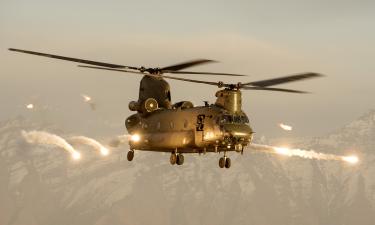Russia’s strategic bombers trouble quite Europe
Two F-16 fighter jets of Denmark’s Air Force took off for an on-call mission after Russia’s strategic bombers Tu-160 appeared near the country’s air space.
Radars of the Danish air defense system detected the target at about midnight local time. “We contacted Russians at 00:18 a.m. and escorted them for 18 minutes as they continued to fly in the south-western direction. We accompanied the Russian bombers until pilots of the British Air Force intercepted them. Afterwards, we returned to our airbase,” Danish pilot Peter Melgord said.
Russian bombers have never approached Denmark’s air space so close before. Danish news agency Ritzan said that it was the third incident with the participation of Russian combat aircraft near the borders of Denmark. The previous incident took place on October 30. The Russian bombers flew 120 kilometers far from the air space of the country, a member of NATO.
Russian president stated on August 17 that Russia was going to resume the flights of its strategic aviation in remote areas. The flights were suspended in 1992. Putin particularly stated that the Russian aviation should have a new life.
The bombers will patrol the areas of Russia’s active economic activities particularly connected with sea navigation, Putin said.
The news received an extensive coverage in Western press. Many foreign newspapers and magazines wrote that Putin’s decision to resume strategic flights had brought the world back to the cold war era.
Britain’s Typhoon fighter jets took off soon after Putin’s statement: a Russian bomber was approaching the British air space. The Tu-95 bomber eventually returned to Russia.
The Tupolev Tu-160 (NATO reporting name Blackjack) is a supersonic, variable-geometry heavy bomber designed by the Soviet Union. Similar to, but more complex and with more payload capacity than the B-1 Lancer, it was the last Soviet strategic bomber design and the heaviest combat aircraft ever built. Introduced in 1987, production of the aircraft still continues, with 16 currently in service with the Russian Air Force. Its pilots call the Tu-160 the “White Swan”, due to the surprising maneuverability and antiflash white finish of the aircraft.
The Tu-160 bears a strong resemblance to the North American B-1A Lancer, although it is significantly larger, faster and with far greater range. The Blackjack has a blended wing profile and variable-geometry wings, with sweep selectable from 20° to 65°. Full-span slats are used on the leading edges, with double-slotted flaps on the trailing edges. The Tu-160 has a fly-by-wire control system.
Translated by Dmitry Sudakov
Pravda.ru
Subscribe to Pravda.Ru Telegram channel, Facebook, RSS!



